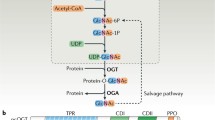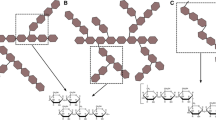Abstract
Amadori products (fructosamines)—ubiquitously occurring in nature—are precursors of the toxic and cell damaging ‘advanced glycation endproducts’; thus, it is not surprising that numerous organisms have developed systems to degrade such compounds. The deglycating enzymes differ with respect to their mechanisms as well as to their substrate specificities. Furthermore, different physiological functions are proposed for the different enzymes. The fructosamine 3-kinases of mammals and homologous proteins (fructosamine 3-kinase related proteins), which are common to all taxa, are thought to focus on intracellular repair functions. In contrast, in Bacillus subtilis and Escherichia coli, the cooperative action of a kinase and a deglycase facilitates Amadori degradation. As genes encoding these enzymes are co-transcribed with ABC transporter genes, it is thought that these genes facilitate the utilisation of extracellular Amadori products. Indeed, it has been shown that fructosamines can serve as the sole carbon and nitrogen sources. Here, we provide an overview of known deglycating systems with the emphasis on Amadori product degradation in bacteria.



Similar content being viewed by others
References
Ahmed MU, Thorpe SR, Baynes JW (1986) Identification of N epsilon-carboxymethyllysine as a degradation product of fructoselysine in glycated protein. J Biol Chem 261:4889–4894
Baek CH, Farrand SK, Lee KE, Park DK, Lee JK, Kim KS (2003) Convergent evolution of Amadori opine catabolic systems in plasmids of Agrobacterium tumefaciens. J Bacteriol 185:513–524
Baynes JW, Thorpe SR (2000) Glycoxidation and lipoxidation in atherogenesis. Free Radic Biol Med 28:1708–1716
Bork P, Sander C, Valencia A (1993) Convergent evolution of similar enzymatic function on different protein folds: the hexokinase, ribokinase, and galactokinase families of sugar kinases. Protein Sci 2:31–40
Brownlee M (1991) Glycosylation products as toxic mediators of diabetic complications. Annu Rev Med 42:159–166
Colas B, Boulanger Y (1983) Glycosylation of yeast aspartyl-tRNA synthetase. Affinity labelling by glucose and glucose 6-phosphate. FEBS Lett 163:175–180
Collard F, Delpierre G, Stroobant V, Matthijs G, Van Schaftingen E (2003) A mammalian protein homologous to fructosamine-3-kinase is a ketosamine-3-kinase acting on psicosamines and ribulosamines but not on fructosamines. Diabetes 52:2888–2895
Collard F, Wiame E, Bergans N, Fortpied J, Vertommen D, Vanstapel F, Delpierre G, Van Schaftingen E (2004) Fructosamine 3-kinase-related protein and deglycation in human erythrocytes. Biochem J 382:137–143
Delplanque J, Delpierre G, Opperdoes FR, Van Schaftingen E (2004) Tissue distribution and evolution of fructosamine 3-kinase and fructosamine 3-kinase-related protein. J Biol Chem 279:46606–46613
Dimitrova R, Mironova R, Ivanov I (2004) Glycation of proteins in Escherichia coli: Effect of nutrient broth ingredients on glycation. Biotechnol Biotechnol 18:99–103
Erbersdobler HF, Faist V (2001) Metabolic transit of Amadori products. Nahrung 45:177–181
Ferri S, Sakaguchi A, Goto H, Tsugawa W, Sode K (2005) Isolation and characterization of a fructosyl-amine oxidase from an Arthrobacter sp. Biotechnol Lett 27:27–32
Fortpied J, Gemayel R, Stroobant V, van Schaftingen E (2005) Plant ribulosamine/erythrulosamine 3-kinase, a putative protein-repair enzyme. Biochem J 388:795–802
Fortpied J, Maliekal P, Vertommen D, Van Schaftingen E (2006) Magnesium-dependent phosphatase-1 is a protein-fructosamine-6-phosphatase potentially involved in glycation repair. J Biol Chem 281:18378–18385
Fortpied J, Gemayel R, Vertommen D, Van Schaftingen E (2007) Identification of protein-ribulosamine-5-phosphatase as human low-molecular-mass protein tyrosine phosphatase-A. Biochem J 406:139–145
Gemayel R, Fortpied J, Rzem R, Vertommen D, Veiga-da-Cunha M, Van Schaftingen E (2007) Many fructosamine 3-kinase homologues in bacteria are ribulosamine/erythrulosamine 3-kinases potentially involved in protein deglycation. FEBS J 274:4360–4374
Haney DN, Bunn HF (1976) Glycosylation of hemoglobin in vitro: affinity labeling of hemoglobin by glucose-6-phosphate. Proc Natl Acad Sci USA 73:3534–3538
Hodge JE (1953) Chemistry of browning reactions in models systems. J Agric Food Chem 1:928–943
Iwashige K, Kouda K, Kouda M, Horiuchi K, Takahashi M, Nagano A, Tanaka T, Takeuchi H (2004) Calorie restricted diet and urinary pentosidine in patients with rheumatoid arthritis. J Physiol Anthropol Appl Hum Sci 23:19–24
Kappler F, Schwartz ML, Su B, Tobia AM, Brown T (2001) DYN 12, a small molecule inhibitor of the enzyme amadorase, lowers plasma 3-deoxyglucosone levels in diabetic rats. Diabetes Technol Ther 3:609–616
Katz C, Cohen-Or I, Gophna U, Ron EZ (2010) The ubiquitous conserved glycopeptidase Gcp prevents accumulation of toxic glycated proteins. mBio 1:195–210
Kim KS, Farrand SK (1996) Ti plasmid-encoded genes responsible for catabolism of the crown gall opine mannopine by Agrobacterium tumefaciens are homologs of the T-region genes responsible for synthesis of this opine by the plant tumor. J Bacteriol 178:3275–3284
Li C, Clarke S (1992) A protein methyltransferase specific for altered aspartyl residues is important in Escherichia coli stationary-phase survival and heat-shock resistance. Proc Natl Acad Sci USA 89:9885–9889
Lin Z, Zheng J (2010) Occurrence, characteristics, and applications of fructosyl amine oxidases (amadoriases). Appl Microbiol Biotechnol 86:1613–1619
Lyons TJ, Jenkins AJ (1997) Glycation, oxidation and lipoxidation in the development of the complications of diabetes: a carbonyl stress hypothesis. Diabetes Rev 5:365–391
Machiels D, Istasse L (2002) Maillard reaction: importance and applications in food chemistry. Ann Méd Vét 146:347–352
Mironova R, Niwa T, Hayashi H, Dimitrova R, Ivanov I (2001) Evidence for non-enzymatic glycosylation in Escherichia coli. Mol Microbiol 39:1061–1068
Nursten H (2005) The Maillard reaction chemistry, biochemistry and implications. Royal Society of Chemistry, Cambridge
Orchard LM, Kornberg HL (1990) Sequence similarities between the gene specifying 1-phosphofructokinase (fruK), genes specifying other kinases in Escherichia coli K12, and lacC of Staphylococcus aureus. Proc Biol Sci 242:87–90
Resch M, Schiltz E, Titgemeyer F, Muller YA (2010) Insight into the induction mechanism of the GntR/HutC bacterial transcription regulator YvoA. Nucleic Acids Res 38:2485–2497
Saitou N, Nei M (1987) The neighbor-joining method: a new method for reconstructing phylogenetic trees. Mol Biol Evol 4:406–425
Saxena AK, Saxena P, Monnier VM (1996) Purification and characterization of a membrane-bound deglycating enzyme (1-deoxyfructosyl alkyl amino acid oxidase, EC 1.5.3) from a Pseudomonas sp. soil strain. J Biol Chem 271:32803–32809
Shallenberger RS (1974) Occurrence of various sugars in foods. In: Sipple HL, McNuttt KW (eds) Sugars in nutrition. Academic, New York, pp 67–80
Srebreva LN, Stoynev GA, Ivanov IG (2009) Evidence for excretion of glycation agents from E. coli cells during growth. Biotechnol Biotechnol 23:1068–1071
Stevens VJ, Vlassara H, Abati A, Cerami A (1977) Nonenzymatic glycosylation of hemoglobin. J Biol Chem 252:2998–3002
Stevens VJ, Rouzer CA, Monnier VM, Cerami A (1978) Diabetic cataract formation: potential role of glycosylation of lens crystallins. Proc Natl Acad Sci USA 75:2918–2922
Szwergold BS, Howell S, Beisswenger PJ (2001) Human fructosamine-3-kinase: purification, sequencing, substrate specificity, and evidence of activity in vivo. Diabetes 50:2139–2147
Takahashi M, Pischetsrieder M, Monnier VM (1997) Isolation, purification, and characterization of amadoriase isoenzymes (fructosyl amine-oxygen oxidoreductase EC 1.5.3) from Aspergillus sp. J Biol Chem 272:3437–3443
Van Schaftingen E, Delpierre G, Collard F, Fortpied J, Gemayel R, Wiame E, Veiga-da-Cunha M (2007) Fructosamine 3-kinase and other enzymes involved in protein deglycation. Adv Enzyme Regul 47:261–269
Wiame E, Van Schaftingen E (2004) Fructoselysine 3-epimerase, an enzyme involved in the metabolism of the unusual Amadori compound psicoselysine in Escherichia coli. Biochem J 378:1047–1052
Wiame E, Delpierre G, Collard F, Van Schaftingen E (2002) Identification of a pathway for the utilization of the Amadori product fructoselysine in Escherichia coli. J Biol Chem 277:42523–42529
Wiame E, Duquenne A, Delpierre G, Van Schaftingen E (2004) Identification of enzymes acting on alpha-glycated amino acids in Bacillus subtilis. FEBS Lett 577:469–472
Wiame E, Lamosa P, Santos H, Van Schaftingen E (2005) Identification of glucoselysine-6-phosphate deglycase, an enzyme involved in the metabolism of the fructation product glucoselysine. Biochem J 392:263–269
Wu LF, Reizer A, Reizer J, Cai B, Tomich JM, Saier MH Jr (1991) Nucleotide sequence of the Rhodobacter capsulatus fruK gene, which encodes fructose-1-phosphate kinase: evidence for a kinase superfamily including both phosphofructokinases of Escherichia coli. J Bacteriol 173:3117–3127
Yoshida N, Sakai Y, Serata M, Tani Y, Kato N (1995) Distribution and properties of fructosyl amino acid oxidase in fungi. Appl Environ Microbiol 61:4487–4489
Author information
Authors and Affiliations
Corresponding author
Rights and permissions
About this article
Cite this article
Deppe, V.M., Bongaerts, J., O’Connell, T. et al. Enzymatic deglycation of Amadori products in bacteria: mechanisms, occurrence and physiological functions. Appl Microbiol Biotechnol 90, 399–406 (2011). https://doi.org/10.1007/s00253-010-3083-4
Received:
Revised:
Accepted:
Published:
Issue Date:
DOI: https://doi.org/10.1007/s00253-010-3083-4




